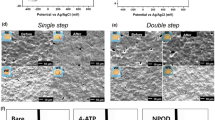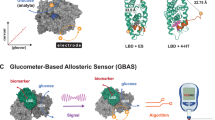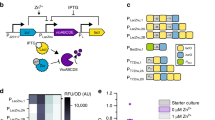Abstract
The cellular level of nicotinamide adenine dinucleotide (NAD+), through its different functions, affects cellular metabolism and signalling1,2,3. A decrease in the NAD+ content has been associated with various pathologies and physiological aging4,5, while strategies to boost cellular NAD+ levels have been shown to be effective against age-related diseases in many animal models6. The link between decreased NAD+ levels and numerous pathologies and physiological aging has triggered the need for a simple quantification method for NAD+, ideally applicable at the point of care. Here, we introduce a bioluminescent biosensor for the rapid quantification of NAD+ levels in biological samples, which can be used either in laboratories or at the point of care. The biosensor is a semisynthetic, light-emitting sensor protein that changes the colour of emitted light from blue to red on binding of NAD+. This NAD+-dependent colour change enables the use of the biosensor in paper-based assays in which NAD+ is quantified by measuring the colour of the emitted light by using either a simple digital camera or a plate reader. We used the approach to quantify NAD+ levels in cell culture, tissue and blood samples, yielding results that agreed with those from standard testing methods. The same biosensor furthermore allows the quantification of NAD+-dependent enzymatic activities in blood samples, thus expanding its utility as a tool for point-of-care diagnostics.
This is a preview of subscription content, access via your institution
Access options
Access Nature and 54 other Nature Portfolio journals
Get Nature+, our best-value online-access subscription
$29.99 / 30 days
cancel any time
Subscribe to this journal
Receive 12 digital issues and online access to articles
$119.00 per year
only $9.92 per issue
Buy this article
- Purchase on Springer Link
- Instant access to full article PDF
Prices may be subject to local taxes which are calculated during checkout



Similar content being viewed by others
Data availability
The data that support the findings of this study are available from the corresponding author upon request. Source data for Figs. 1–3 and Extended Data Figs. 3–9 are provided with the paper. Plasmids of the sensors are available on AddGene through No.135627 (NAD-Luc), 135628 (NAD-cpLuc) and 135629 (NAD-cpLuc2).
References
Belenky, P., Bogan, K. L. & Brenner, C. NAD+ metabolism in health and disease. Trends Biochem. Sci. 32, 12–19 (2007).
Canto, C., Menzies, K. J. & Auwerx, J. NAD+ metabolism and the control of energy homeostasis: a balancing act between mitochondria and the nucleus. Cell Metab. 22, 31–53 (2015).
Fang, E. F. et al. NAD+ in aging: molecular mechanisms and translational implications. Trends Mol. Med. 23, 899–916 (2017).
Rajman, L., Chwalek, K. & Sinclair, D. A. Therapeutic potential of NAD-boosting molecules: the in vivo evidence. Cell Metab. 27, 529–547 (2018).
Katsyuba, E. & Auwerx, J. Modulating NAD+ metabolism, from bench to bedside. EMBO J. 36, 2670–2683 (2017).
Yoshino, J., Baur, J. A. & Imai, S. I. NAD+ intermediates: the biology and therapeutic potential of NMN and NR. Cell Metabol. 27, 513–528 (2018).
Trammell, S. A. J. et al. Nicotinamide riboside is uniquely and orally bioavailable in mice and humans. Nat Commun 7, 12948 (2016).
Karp, M. T., Raunio, R. P. & Lövgren, T. N. Simultaneous extraction and combined bioluminescent assay of NAD+ and NADH. Anal Biochem. 128, 175–180 (1983).
Yu, Q. et al. Semisynthetic sensor proteins enable metabolic assays at the point of care. Science 361, 1122–1126 (2018).
Sallin, O. et al. Semisynthetic biosensors for mapping cellular concentrations of nicotinamide adenine dinucleotides. eLife 7, e32638 (2018).
Keppler, A. et al. A general method for the covalent labeling of fusion proteins with small molecules in vivo. Nat Biotechnol 21, 86–89 (2003).
Los, G. V. et al. HaloTag: a novel protein labeling technology for cell imaging and protein analysis. ACS Chem. Biol. 3, 373–382 (2008).
Auld, D. S. et al. Characterization and use of TurboLuc luciferase as a reporter for high-throughput assays. Biochemistry 57, 4700–4706 (2018).
Griss, R. et al. Bioluminescent sensor proteins for point-of-care therapeutic drug monitoring. Nat. Chem. Biol. 10, 598–603 (2014).
Hasmann, M. & Schemainda, I. FK866, a highly specific noncompetitive inhibitor of nicotinamide phosphoribosyltransferase, represents a novel mechanism for induction of tumor cell apoptosis. Cancer Res. 63, 7436–7442 (2003).
Wood, J. G. et al. Sirtuin activators mimic caloric restriction and delay ageing in metazoans. Nature 430, 686–689 (2004).
Chen, D. et al. Tissue-specific regulation of SIRT1 by calorie restriction. Genes Dev. 22, 1753–1757 (2008).
Gariani, K. et al. Eliciting the mitochondrial unfolded protein response by nicotinamide adenine dinucleotide repletion reverses fatty liver disease in mice. Hepatology 63, 1190–1204 (2016).
Extermann, M. et al. Predicting the risk of chemotherapy toxicity in older patients: the Chemotherapy Risk Assessment Scale for High-Age Patients (CRASH) score. Cancer 118, 3377–3386 (2012).
Vanderlinde, R. E. Measurement of total lactate dehydrogenase activity. Ann. Clin. Lab. Sci. 15, 13–31 (1985).
Pollock, N. R. et al. A paper-based multiplexed transaminase test for low-cost, point-of-care liver function testing. Sci. Transl. Med. 4, 152ra129 (2012).
Algar, E. M., Seeley, T. L. & Holmes, R. S. Purification and molecular properties of mouse alcohol dehydrogenase isozymes. Eur. J. Biochem. 137, 139–147 (1983).
Acknowledgements
This work was supported by the Max Planck Society, the Swiss National Science Foundation and EPFL.
Author information
Authors and Affiliations
Contributions
Q.Y. and K.J. conceived this study. Q.Y., N.P., L.X., C.G., S.F., D.B., L.P., E.K., J.A. and K.J. performed experiments, provided samples, performed data analysis and contributed to manuscript writing.
Corresponding author
Ethics declarations
Competing interests
K.J. is inventor on a patent application filed by EPFL. Patent number: US10221439B2; Sensors, methods and kits for detecting nicotinamide adenine dinucleotides. J.A. is a consultant to Mitobridge. All other authors declare no conflict of interest.
Additional information
Peer review information Primary Handling Editor(s): Ana Mateus; Christoph Schmitt.
Publisher’s note Springer Nature remains neutral with regard to jurisdictional claims in published maps and institutional affiliations.
Extended data
Extended Data Fig. 1 Improving sensor performance using cpNLuc.
The distance between the active site (glowing blue ball) and the fluorophore Cy3 is shortened when using cpNLuc as the BRET donor, resulting in a higher energy transfer efficiency in the closed state of the sensor.
Extended Data Fig. 2 Cofactor binding site of wild-type hSPR.
Residues contributing to cofactor binding and randomized for improving NAD+ binding affinity of the BRET sensor are highlighted in yellow. The selected mutant NAD-cpLuc2 carries the SPR mutation A41D, R42L and R17K. The SPR used for the generation of sensor NAD-Luc and NAD-cpLuc contains the mutation A41D and R42W to switch the cofactor sensitivity from NADP+ to NAD+. SPR PDB ID = 4HWK.
Extended Data Fig. 3 Titration of NAD-cpLuc and NAD-cpLuc2.
Titration curve of a, NAD-cpLuc and b, NAD-cpLuc2 with various cofactors and biosynthetic precursors of NAD+. Error bars represent ± SD of n = 3 independent measurements.
Extended Data Fig. 4 Modularity of BRET sensor components.
a, Cartoon of the sensor using TLuc as BRET donor. b, Performance of the sensor using TLuc as BRET donor. The resulting sensor showed a smaller signal response compared to the cpNLuc-based sensor. c, Cartoon of the sensor using HaloTag (Halo) as the self-labeling protein. d, Performance of the sensor using HaloTag for attaching fluorescent sulfamethoxazole derivative Halo-PEG11-Cy3-SMX. The structure of Halo-PEG11-Cy3-SMX and its synthesis is described in the section “SYNTHESIS OF COMPOUNDS”. Error bars represent ± SD of n = 3 independent measurements.
Extended Data Fig. 5 NAD+ quantification by test paper for samples prepared with and without centrifugation step.
a, cell lysate, b, homogenized mice liver and c, spiked human blood. Error bars represent ± SD of n = 3 independent measurements.
Extended Data Fig. 6 Stability of test paper emission ratio during 5 min measurement.
The ratio was monitored by camera after spotting samples with known NAD+ concentrations onto the test paper. The stable ratio indicates a minimal sample evaporation and signal drift. The experiment was repeated three times independently with similar results.
Extended Data Fig. 7 Measurement of enzymatic activities in plasma.
a, The measurement of spiked ALT in plasma. b, The measurement of spiked AST in plasma. Error bars represent ± SD of n = 3 independent measurements.
Extended Data Fig. 8 Stability of test paper under room temperature storage.
The stability is evaluated by measuring a, total light intensity, b, Ro and Rc, and c, c50. The values were given as mean ± SD of n = 3 independent measurements.
Extended Data Fig. 9 Effect of 1 U/mL alcohol dehydrogenase (ADH from S. cerevisiae) on sample NAD+ stability.
The natural level of ADH (1 U/mL) converted no more than 20% of the NAD+ in the sample treated using the current method compared to a method using 50 mM ADH inhibitor (4-methylpyrazole hydrochloride). Error bars represent mean ± SD of n = 3 independent measurements.
Supplementary information
Supplementary Information
Supplementary Tables 1 and 2, and Methods
Source data
Source Data Fig. 1
Statistical Source Data
Source Data Fig. 2
Statistical Source Data
Source Data Fig. 3
Statistical Source Data
Source Data Extended Data Fig. 3
Statistical Source Data
Source Data Extended Data Fig. 4
Statistical Source Data
Source Data Extended Data Fig. 5
Statistical Source Data
Source Data Extended Data Fig. 6
Statistical Source Data
Source Data Extended Data Fig. 7
Statistical Source Data
Source Data Extended Data Fig. 8
Statistical Source Data
Source Data Extended Data Fig. 9
Statistical Source Data
Rights and permissions
About this article
Cite this article
Yu, Q., Pourmandi, N., Xue, L. et al. A biosensor for measuring NAD+ levels at the point of care. Nat Metab 1, 1219–1225 (2019). https://doi.org/10.1038/s42255-019-0151-7
Received:
Accepted:
Published:
Issue Date:
DOI: https://doi.org/10.1038/s42255-019-0151-7
This article is cited by
-
Meta-analysis of NAD(P)(H) quantification results exhibits variability across mammalian tissues
Scientific Reports (2023)
-
A plug-and-play platform of ratiometric bioluminescent sensors for homogeneous immunoassays
Nature Communications (2021)
-
De novo design of modular and tunable protein biosensors
Nature (2021)
-
NAD+ homeostasis in health and disease
Nature Metabolism (2020)



